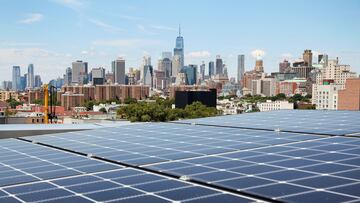Requirements to receive up to 30% for the tax credit for solar panels in 2024
The Residential Clean Energy Credit got a boost under the Inflation Reduction Act allowing taxpayers to recoup up to 30% of an investment in solar panels.

The US Congress passed a bipartisan bill in 2022 to increase investment in the United States. One of the provisions in the Inflation Reduction Act was a boost to the tax credit for those who invest in energy saving improvements.
The previous tax credit was 26 percent available in 2020 and 2021. However, starting in 2022, those who installed new solar panels, or invested in an off-site community solar project, could get a tax credit of up to 30 percent through the Residential Clean Energy Credit.
There is no maximum amount that can be claimed. The new credit amount will be available through 2032, after which it will gradually decrease over the subsequent two years before expiring in 2035. Here’s a look at the requirements to receive the credit.
Did you install solar panels in your home between 2017 and today? If so, you may be eligible for a tax credit. Learn more about what types of solar energy systems are eligible, as well as key dates and installation deadlines through the link below: https://t.co/dzU4SiRhw4
— Office of Energy Efficiency and Renewable Energy (@eeregov) March 14, 2023
Requirements to receive up to 30% for the tax credit for solar panels in 2024
The tax credit, which can be claimed when one files their income tax return, discounts the cost of installing a solar panel by the taxpayer. For every dollar of the credit a taxpayer can receive, it will reduce their federal income taxes due by the same amount.
The credit is non-reundable, so you cannot get any excess amount over what your tax liability is as a refund. However, any unused portion of the credit may be carried over to the following year.
According to the IRS, the tax credit can be claimed by those who added solar panels to their “house, houseboat, mobile home, cooperative apartment, condominium, and a manufactured home that conforms to Federal Manufactured Home Construction and Safety Standards.”
Additionally, “To qualify for the credit, the property must be certified for performance by the nonprofit Solar Rating Certification Corporation or a comparable entity endorsed by the government of the state in which the property is installed,” the IRS states. While the property does not have to be your main home, it must be used solely by you.
The credit can be claimed once the taxpayer has paid for the solar panels and had them installed, which will generate a total cost that will be reported to the IRS. Critically, the credit must be claimed for the tax year the installation was made. So if you have solar panels installed in 2023, you will need to report that information on the tax return you submit to the IRS when you file your tax return this year.
Those looking to claim the credit must fill out IRS Form 5695.
Expenses, another point to take into account
Since the total value of the credit is based on a percent of the expenditure on the panels, the IRS will examine the following costs:
- Solar panels or cells.
- Contractor labor costs incurred for preparation, assembly, or installation
- The balance of the equipment system.
- Energy storage devices with a capacity of three kilowatts per hour or greater (in the case of those installed after December 31, 2022).
- Sales taxes on eligible expenses.
Note, that if you received a rebate from your ultility company to install solar on your home, the amount received must be subtracted for your total outlay. However, if your state gave you a rebate, that will not affect the amount that you can claim on your federal tax return, and vice versa. However, the credit that you received from your state government may affect how much you must claim in taxable income on your federal form due to the State and Local Taxes (SALT) deduction.
What about previous years?
Related stories
You still may be able to claim the credit for solar installations that were purchased in previous years, but the total value drops to twenty-six percent. Some remuneration will be granted to those who installed panels from 2017-2022 when the credit either did not exist or was worth less than it is today.
For more information about the Federal Tax Credit for Solar Photovoltaics the Office of Energy Efficiency & Renewable Energy has provided a Homeowner’s Guide with some frequently asked questions.

